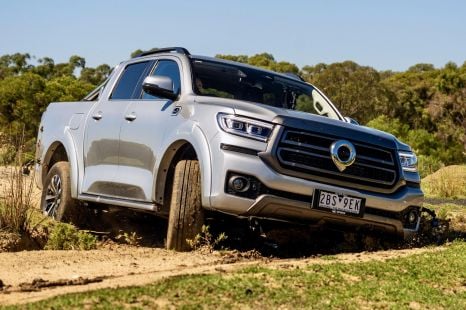

Max Davies
2026 GWM Cannon Ultra review
6 Days Ago
Let's get this out of the way: no, it's not like a real Mustang, but that doesn't mean the Mach-E isn't an impressive car in its own right.
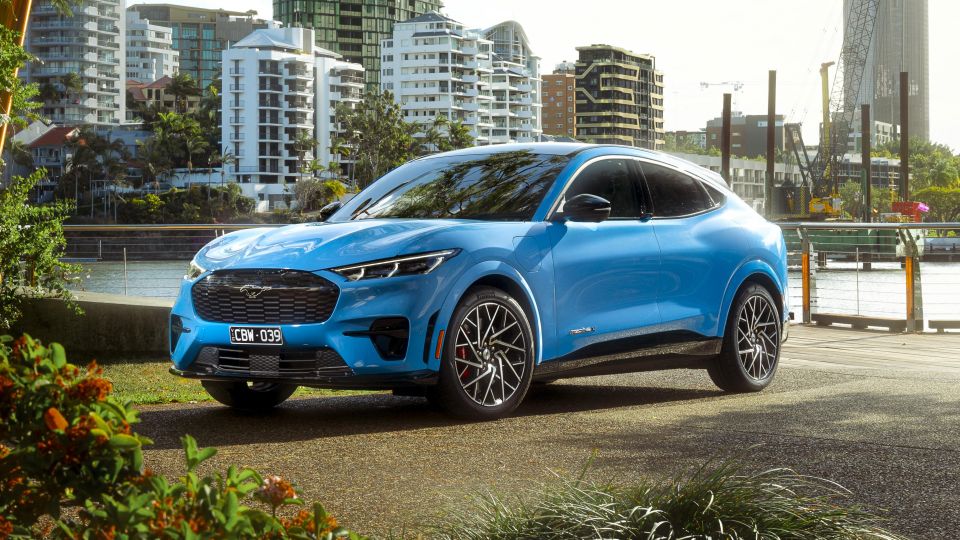
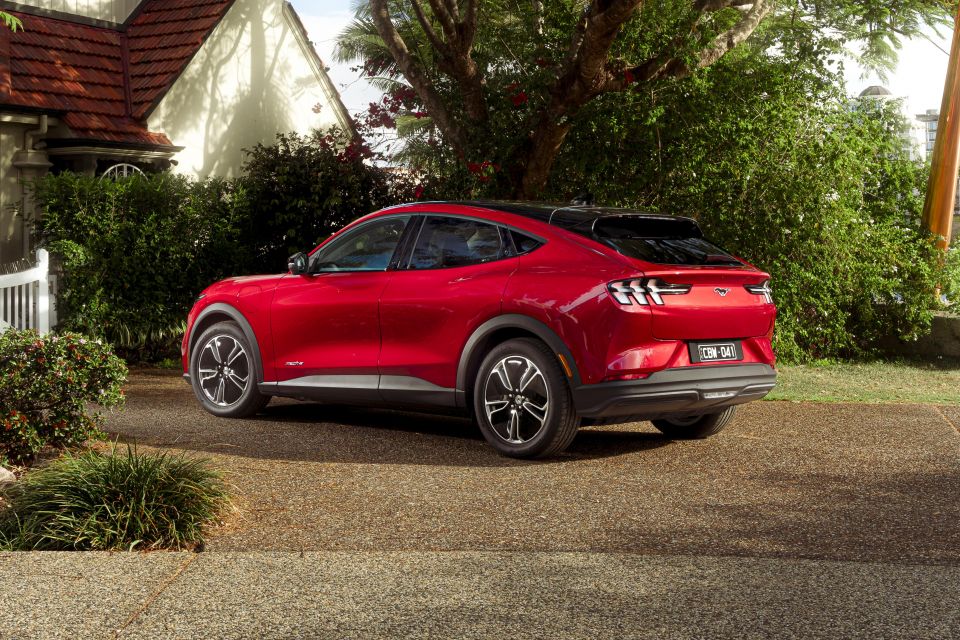

Quickly see how this car stacks up against its competition. Select any benchmark to see more details.
Where expert car reviews meet expert car buying – CarExpert gives you trusted advice, personalised service and real savings on your next new car.
Ford’s new electric SUV is a new product with a familiar name, one that carries with it tremendous brand equity but also the weight of expectations.

It’s hard to ignore the elephant in the room when it’s a Mustang.
The 2024 Ford Mustang Mach-E may look like a Mustang, but it’s wholly unrelated to the combustion-powered coupe and convertible Australia knows and loves.
It’s the first Mustang with available all-wheel drive, the first Mustang with more than three doors, and perhaps most critically, the first Mustang with electric power.
Ford could have just done an Escape/Endura-like electric SUV, but it likely wouldn’t have gotten as much buzz. It may also have avoided the ire of so many dyed in the wool Ford enthusiasts who have slammed the company for putting the iconic Mustang name on, egad, an electric SUV.

To Ford’s credit, while this may be like no other Mustang ever made, it’s recognisably a member of the Mustang family from the outside.
Designers didn’t just slap three-segment tail lights and a couple of pony badges on an Escape-like crossover and call it a day. Instead, this car has bulging haunches and crisp side detailing like a Mustang, as well as a rakish roofline.
Oh, and it also has those three-segment tail lights and pony badges. Of course.
It looks better in person than in photos, and there’s not an enormous difference between the three variants in terms of appearance.
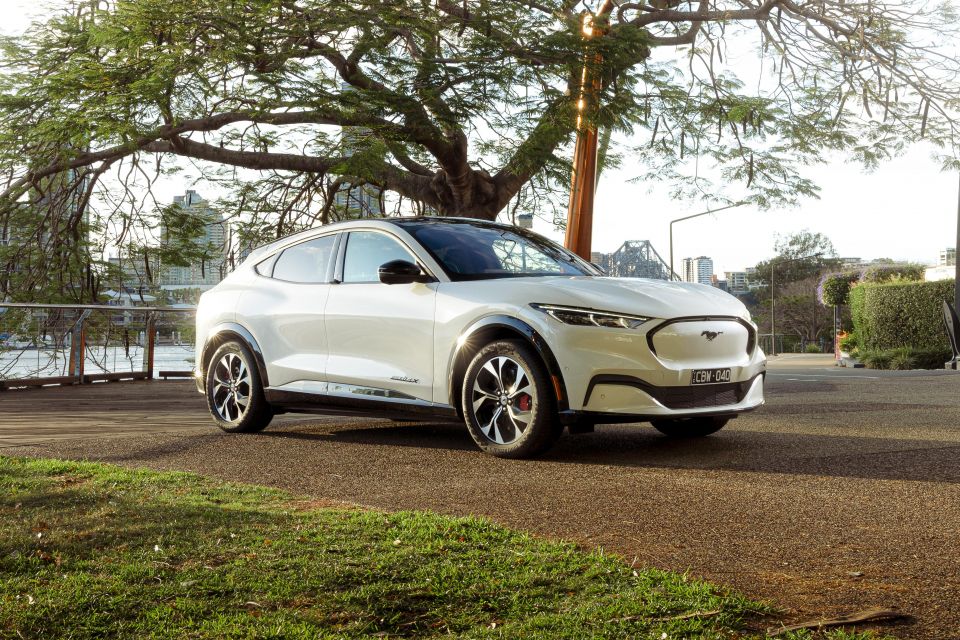
The GT is easily distinguishable via its faux grille and intricate 20-inch alloy wheels, while all three have different wheel arch treatments.
The mid-range Premium has 19-inch alloys like the base Select, but they look a lot better as they do without the dorky aero covers. The Select is also the only variant with reflector instead of projector LED headlights, while there are further (if still subtle) differences inside the cabin – more on that later.
The Mustang Mach-E isn’t cheap. The range opens at $79,990 before on-road costs for the base Select, rising to $91,665 before on-roads for the Premium and topping out at $107,665 for the GT.
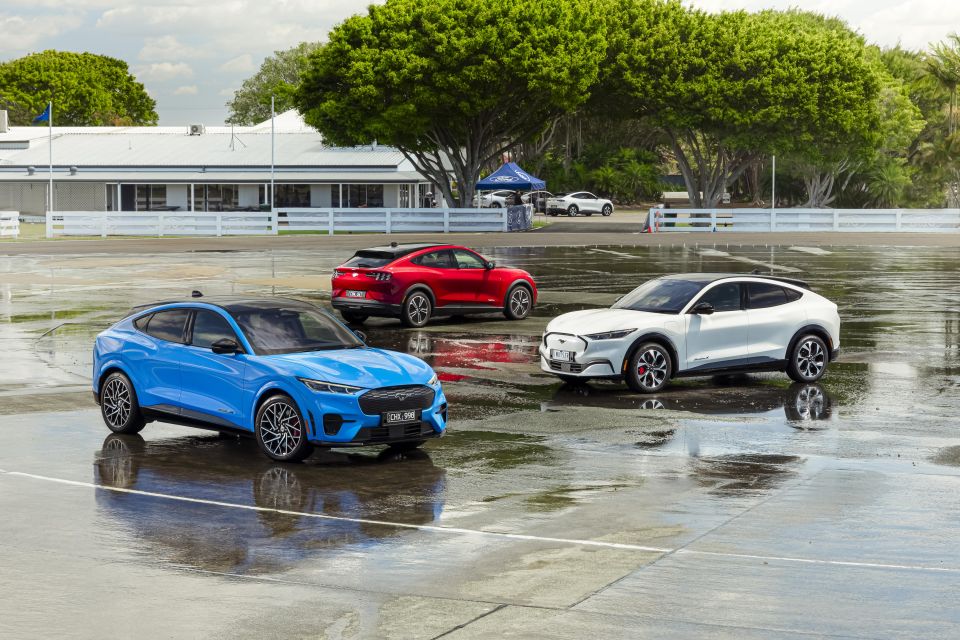
The top-selling Tesla Model Y, in contrast, is priced from $65,400 to $91,400 before on-roads.
Other rivals include:
At this price point, you could also look at smaller electric SUVs from premium brands, such as the BMW iX1 ($78,900-$84,900) and Volvo XC40 Recharge ($76,990-$85,990). All prices listed exclude on-road costs.
Buy your new car without the stress. It's fast, simple and completely free.

Great service from Travis and team, second time I have used this business would not hesitate to recommend them to anyone
Craig C.
Purchased a Ford Ranger in Sunshine Coast, QLD
CarExpert helped Craig save $7,224 on his Ford Ranger, now let us save you on your next new car.
Get your BEST priceRemember how I said the Mach-E looked like a Mustang from the outside? Well, that doesn’t apply to the interior.
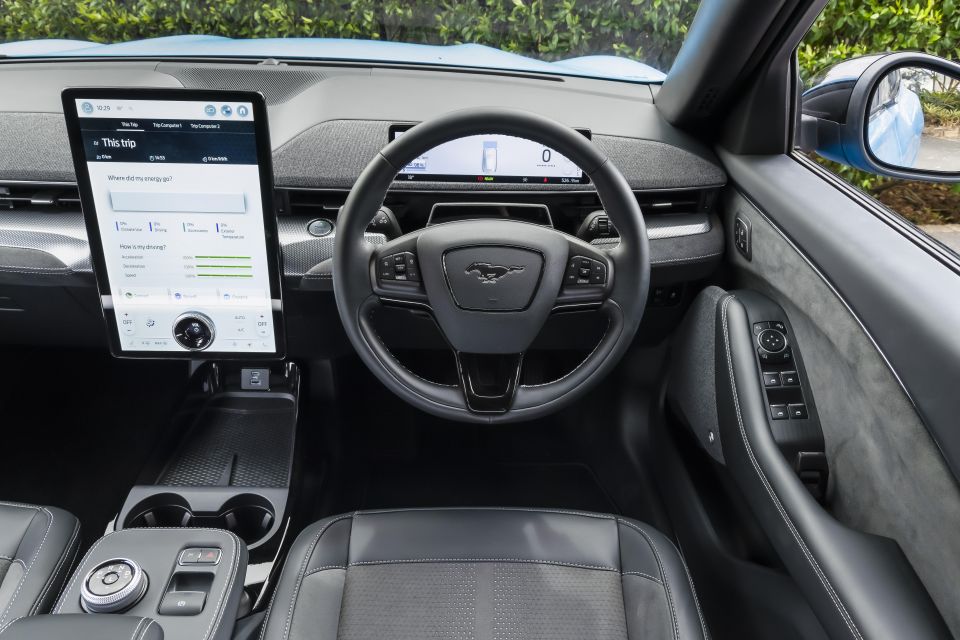
Ford executives say the Mach-E has a dual-cowl look like the outgoing S550 Mustang, though damned if I can see that.
What can be seen, however, is a minimalist interior dominated by a 15.5-inch infotainment touchscreen. The screen is bigger than that in the Ranger and Everest, but the interface will be familiar.
It’s all quite intuitive to use, with shortcut buttons at the top of the screen and climate controls always appearing at the bottom. There’s also a multi-function physical knob towards the base of the screen.
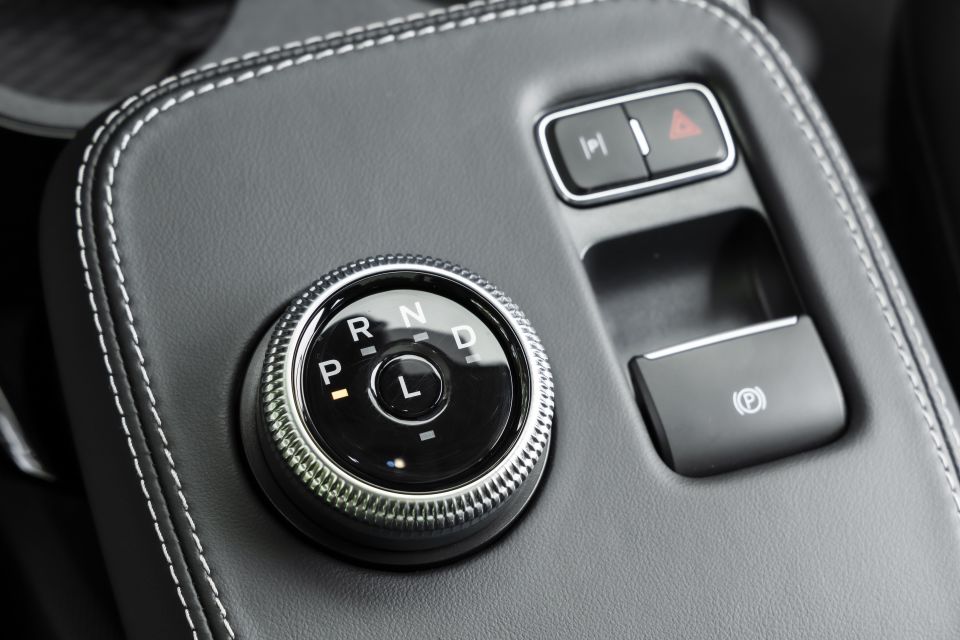
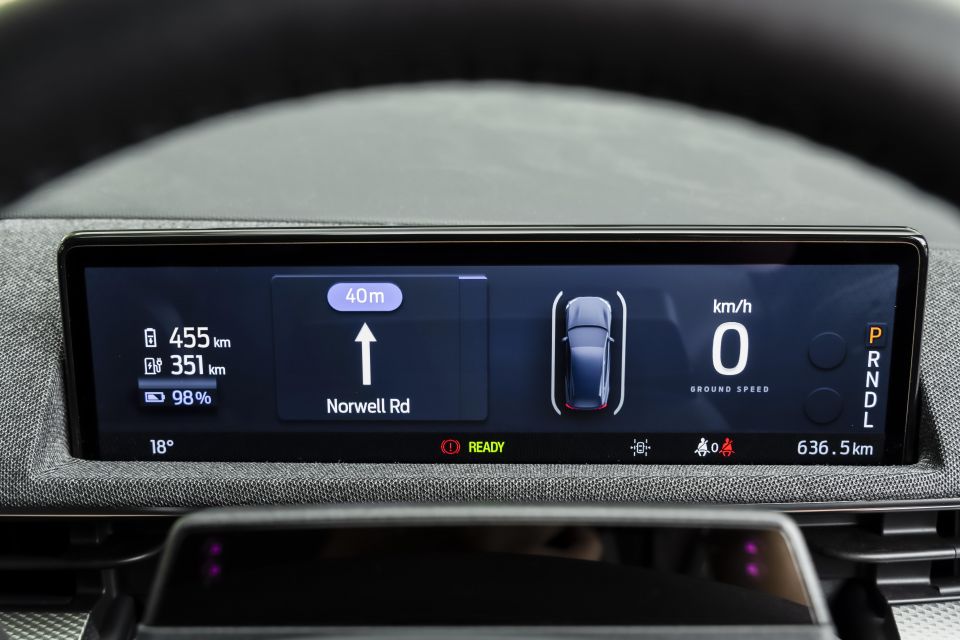
There are other details in the cabin that will look familiar, like the heated windscreen that’s strange to look through at first, as well as steering wheel switchgear shared with models like the Puma. The buttons aren’t fancy, nor is the rotary dial shifter borrowed from the Escape, but it all works well.
The steering wheel itself is satisfying to hold, feeling chunky and tactile. It’s not actually leather-wrapped, with Ford boasting the Mustang Mach-E doesn’t use any animal products whatsoever in its cabin, but it does feel like actual leather.
At the GT’s $100,000+ price tag, the Mustang Mach-E’s interior doesn’t quite look premium enough. At circa-$80,000, it’s a bit more palatable, though still not particularly upscale.
Each variant looks largely the same inside, with the same size instrument cluster and touchscreen, and a sound bar that runs across the dashboard.
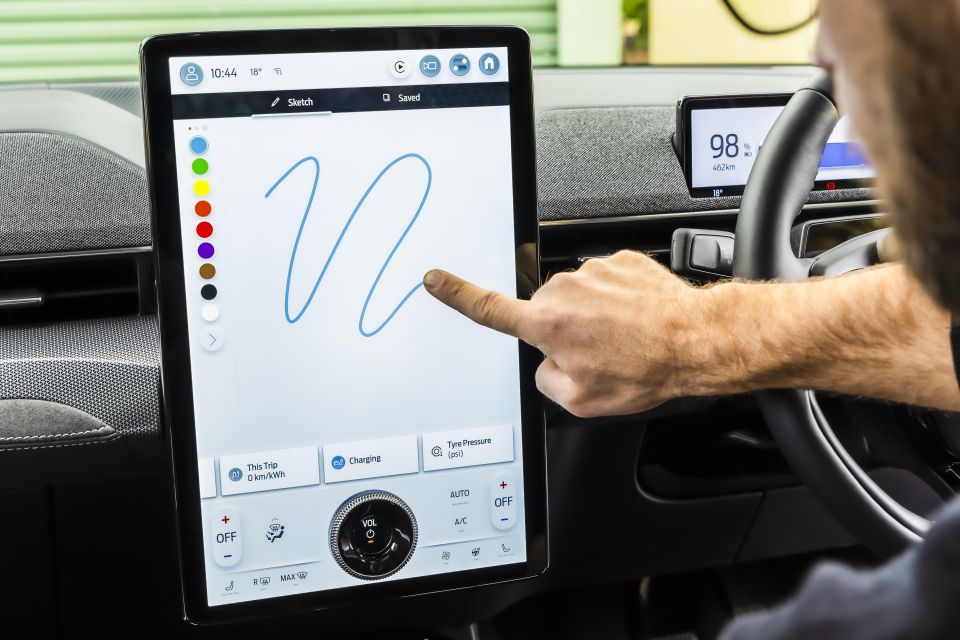
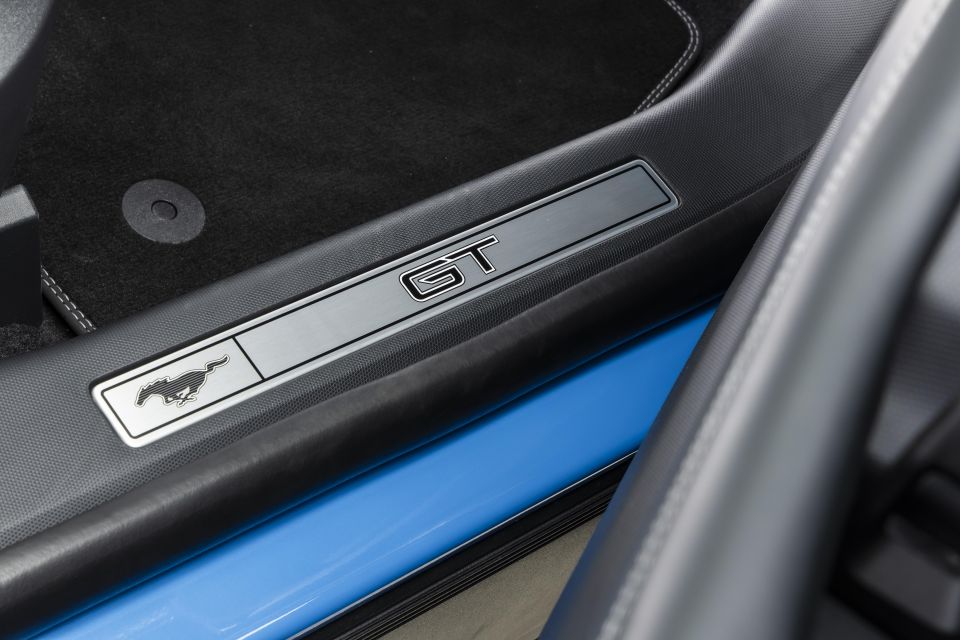
They’re most easily distinguished via the trim applique. The Select has metal-look trim, the Premium faux carbon-fibre that’s a little too faux, and the GT has different metal-look trim. For the GT’s extra outlay, however, we would have liked to see greater differentiation inside, while the Select’s trim inlays are arguably the nicest of the lot.
Disappointingly, Ford hasn’t seen fit to offer the Space Grey interior here. Instead, all models have a black interior, but there are plenty of different materials to help break up the monotony.
There’s no head-up display, but at least you’re not forced to look at the infotainment screen to find out your speed. Instead there’s a slim, minimalist digital instrument cluster ahead of the driver with attractive graphics that change based on your drive mode.
If you get too close to another car, a graphic in the instrument cluster will warn you. With lane centring on, your car’s avatar will show it in a little blue bubble.
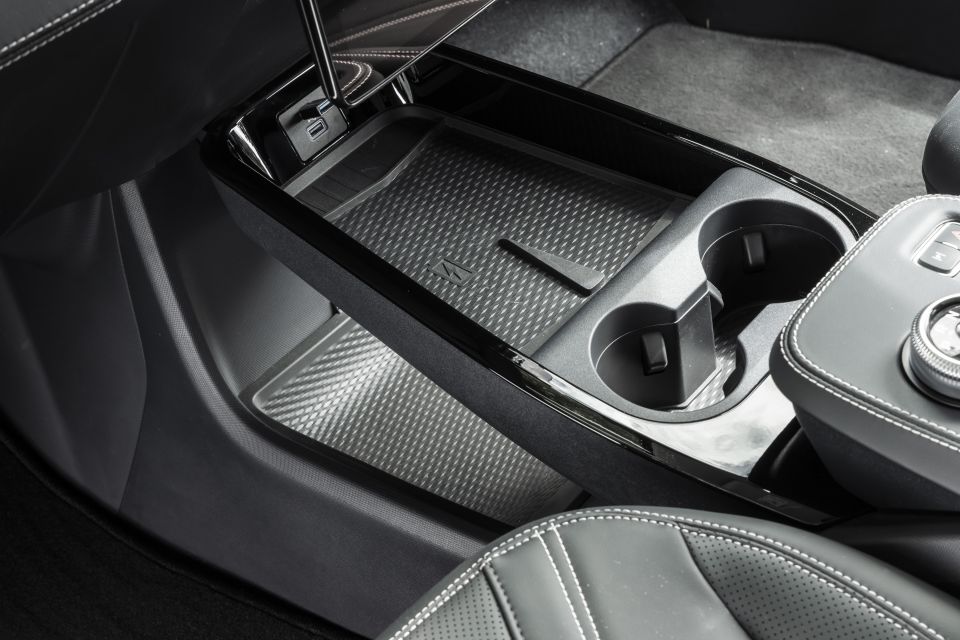
There’s plenty of storage up front. Beneath a rubberised shelf that includes a wireless phone charger, there’s yet another rubberised shelf that’s large enough for you to stow, say, a tablet or handbag. The upper shelf features both a USB-A and a USB-C outlet.
All models have a huge glass roof, and it proved sufficiently tinted to keep the hot Queensland sun at bay. That’s good, as there’s no shade.
I’m 180cm tall, and despite the curvaceous roofline my head only brushes the roof if I sit back. There’s also plenty of leg room, with an almost entirely flat floor.
The centre seat is firm but not uncomfortable and there are air vents back here, plus one USB-C and one USB-A outlet.
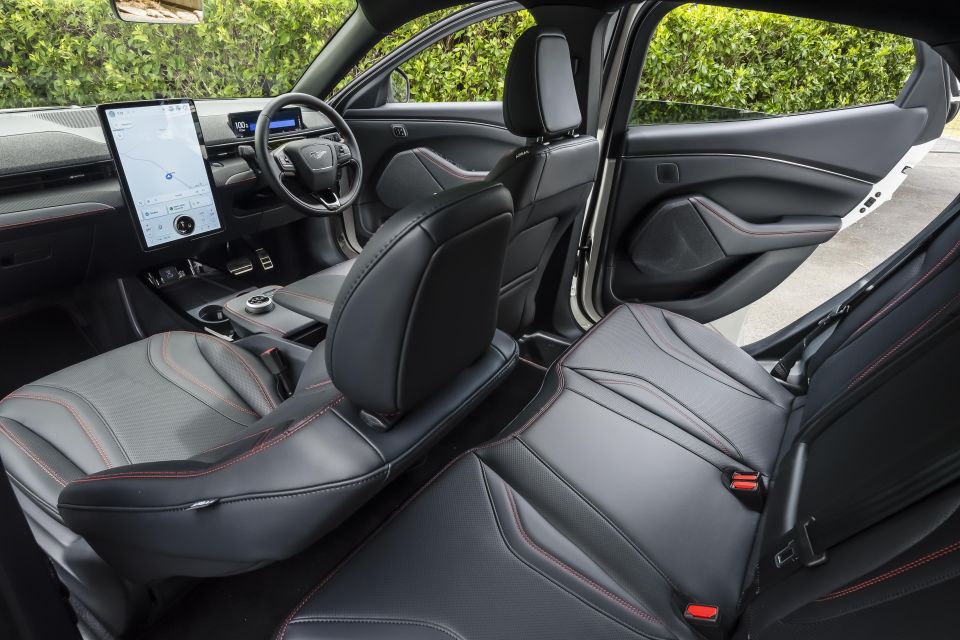
All models have three top-tether and two ISOFIX anchor points for child seats in the second row.
Boot capacity with the rear seats upright is 402 litres, which can be expanded to 1420 litres with the second row folded. The rear bench folds in a 60/40 split configuration. As is common with EVs, there’s no spare tyre – you’ll find only a mobility kit below the boot floor.
All models include 134L of space up front under the bonnet. The storage cavity is washable, drainable and waterproof, making the Mach-E ideal for tailgate (bonnet?) parties. For US regulatory reasons, there’s also an internal release so you can get out if you’re small enough to fit and somehow get stuck.
Ford wanted to be different for the sake of being different with the e-latch door mechanisms. You get used to them, but they serve no functional benefit and any improvement in aerodynamic efficiency would surely be negligible at best.
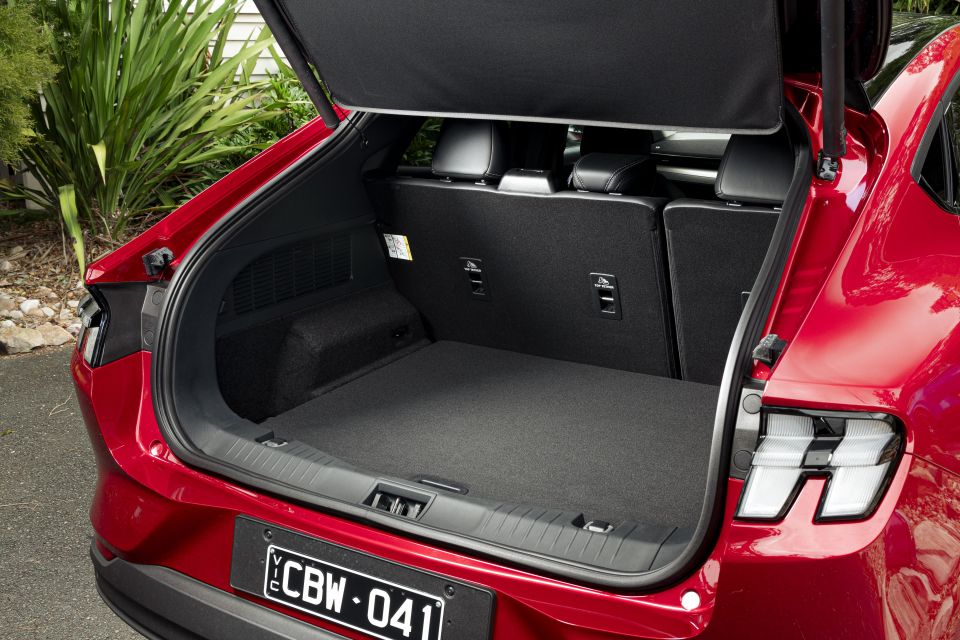
Pressing a button to open a door just doesn’t feel intuitive, even if Ford wants to brag that the use of actuators can stop the door from blowing in the wind. It feels like the solution to a problem nobody was really complaining about.
Inside, the door releases are also found within the door armrests, as in a Ranger or Everest. The idea is of no less dubious merit here than in those models.
Well, nothing technically, except for the aforementioned storage space.
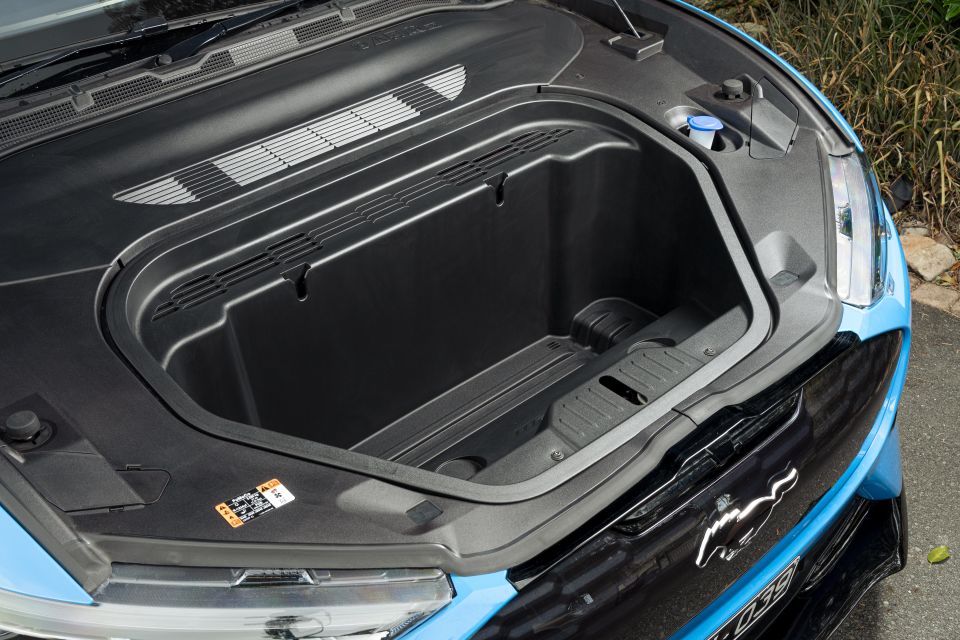
The Select and Premium both feature single, rear-mounted electric motors, with the GT featuring a dual-motor all-wheel drive setup.
The Select produces 198kW of power and 430Nm of torque, the Premium216kW and 430Nm, and the GT 358kW and 860Nm. Ford claims the Select can do the 0-100km/h dash in 6.6 seconds, the Premium in 6.2s, and the GT in just 3.7s.
The Select uses a 72kWh (usable) lithium iron phosphate (LFP) battery sourced from CATL with 470km of WLTP range. It can be charged at up to 10.5kW using AC power and 150kW using DC power. Ford says the 72kWh battery weighs 600kg.
The Premium and GT use a 91kWh (usable) nickel manganese cobalt (NMC) battery sourced from LG with 600km of range (Premium) or 490km of range (GT). This battery weighs 596kg, and can also be charged at up to 10.5kW (AC) and 150kW (DC).
While I wasn’t able to take the vehicles on an identical test loop due to a freak storm, we saw average energy consumption of 18kWh/100km in the Select on a brief drive and 17kWh/100km in the Premium across over a 110km route.

If you’re wondering how the Mach-E stacks up against key rivals, here are some figures:
We had the opportunity to drive all three variants: the rear-wheel drive Select and Premium on the road, and the all-wheel drive GT on a track.
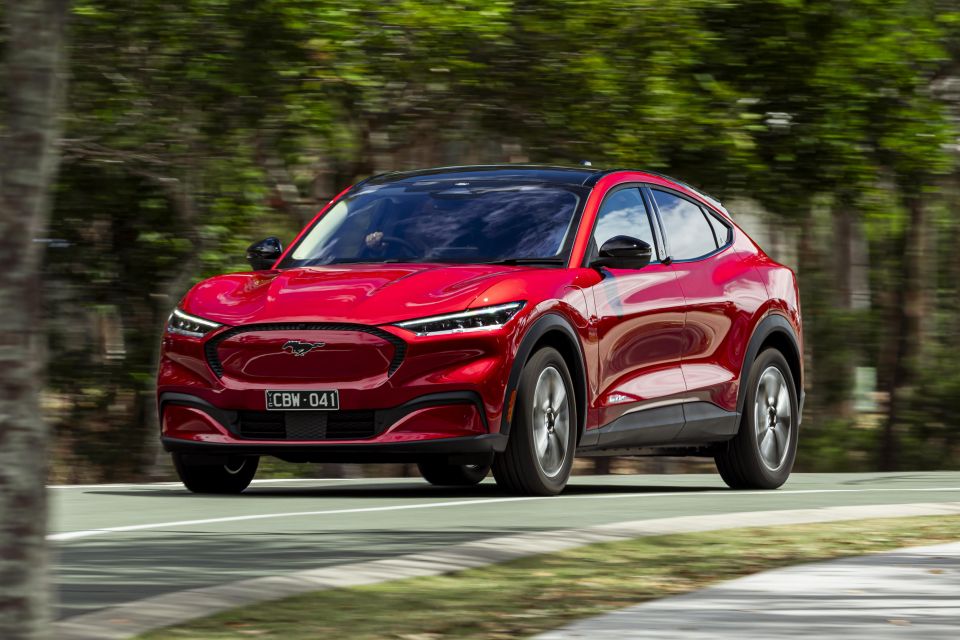
Where expert car reviews meet expert car buying – CarExpert gives you trusted advice, personalised service and real savings on your next new car.
The Mustang Mach-E offers different suspension tunes for North America, Europe, and the UK and Ireland.
Having driven the US tune last year and finding it overly firm, bordering on harsh, I was bracing myself for a stiff ride in the Australian-market Mach-E, which uses what Ford calls the Irish tune. After all, American buyers would want a plusher ride, right?
When it comes to the Mach-E, however, that rule of thumb doesn’t hold true.
The Irish tune is vastly more pliant. We drove the Select and Premium over a mix of surfaces, from smooth bitumen to concrete motorways to patchier pavement, and not once did the Mach-E crash or thump over a rut in the road.
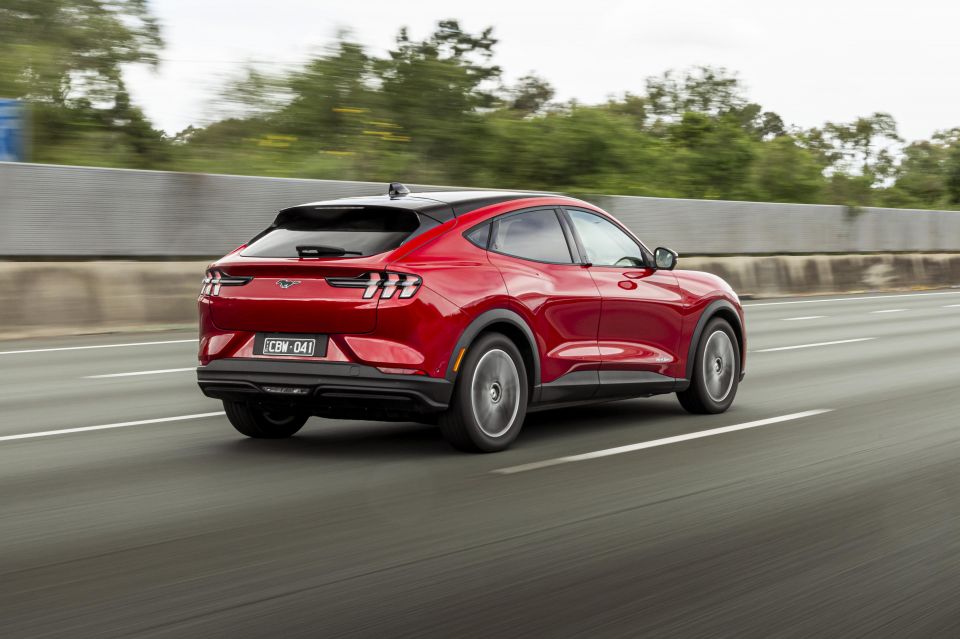
It’s not perfect. It does fidget a bit on tarmac, and doesn’t feel quite as settled at the rear as I’d like. Overall, however, it’s generally pretty smooth and vastly less stiff than North American models.
If you drive the Mach-E and still don’t find the ride to your liking, well, suffice it to say you’d loathe the North American tune even more.
In terms of body control, the Mach-E didn’t pitch and heave over surface changes and expansion joints like we’ve experienced with some vehicles with bulky batteries. It feels nicely tied down, which also makes the Mach-E feel dynamic.
There’s a balanced rear-wheel drive chassis under the Mach-E’s shapely bodywork, and though a freak summer storm (in spring?!) drenched the roads and stopped us from really pushing it, the Mach-E gave an overall impression of great poise.
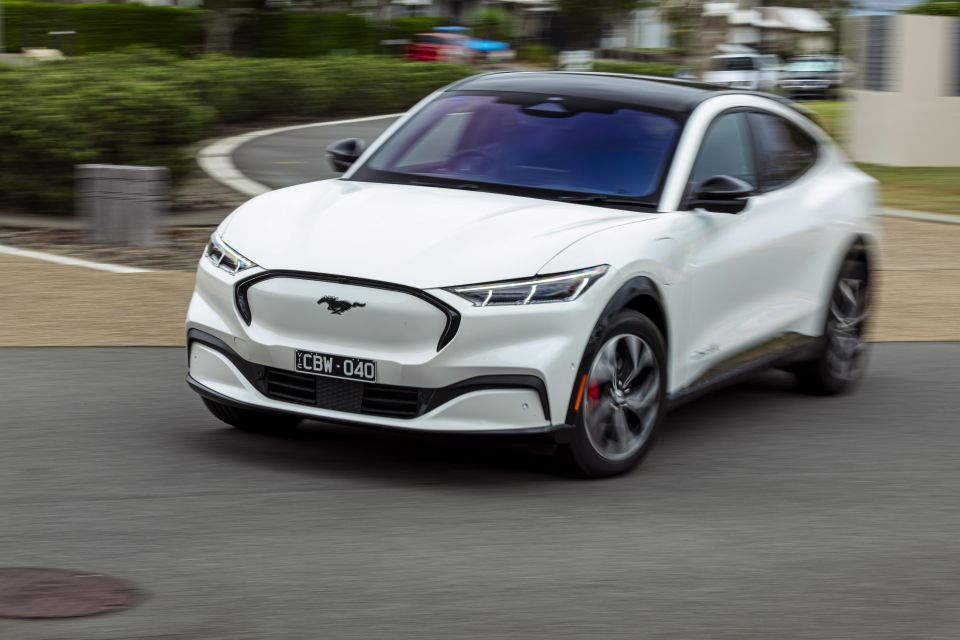
The centre of gravity seems low, and it feels hunkered down and planted in corners. You peer out over a long bonnet, too, which feels very on-brand for a Mustang.
The steering isn’t the most feelsome or communicative, but it’s well-weighted and putting it in Untame (aka Sport) mode will add more weight.
Even in Untame mode, the Mach-E Premium doesn’t really push you back in your seat. Power delivery is smooth, however, and the Mach-E always feels responsive.
The ‘main’ drive mode is called Active, while there’s also Whisper which is designed for bad weather – perfect for the day we had in the cars.
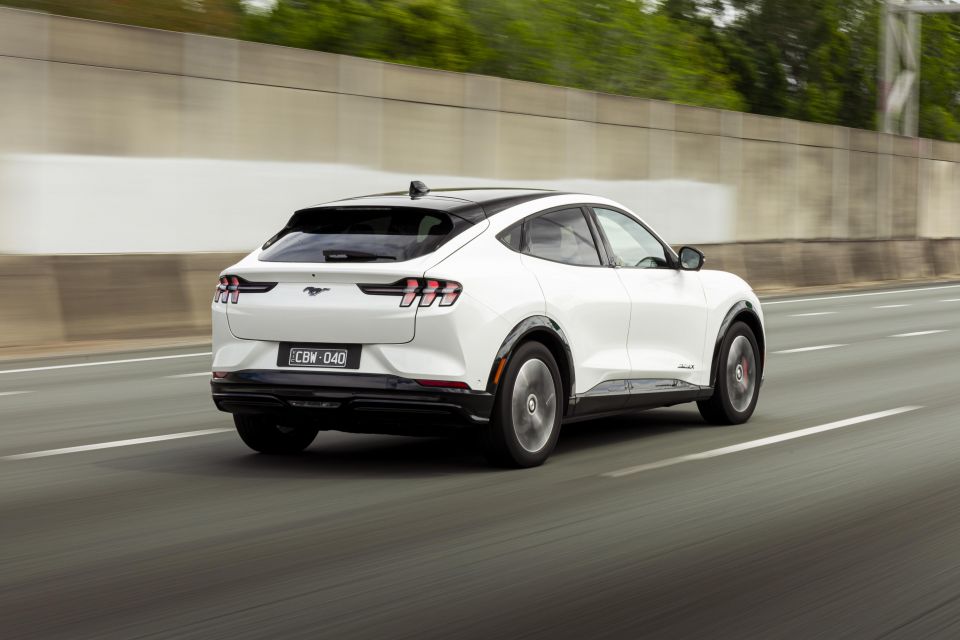
Frustratingly, there’s no physical drive mode selector – an odd choice for what’s ostensibly a sporty car. We’d love to see a button on the steering wheel or even on the centre console, instead of the awkward way you have to select drive modes: press what looks like a settings button on the top of the touchscreen, wait for the page to load, and then toggle to a different mode.
Through the drive mode screen, you can also activate the one-pedal drive mode and auto hold functions and adjust the propulsion sound. The one-pedal drive mode does allow you to bring the vehicle to a complete stop without touching the brake pedal.
The Mach-E impresses with its refinement. Its cabin is particularly well insulated – at highway speeds, on a windy day, on rough rural roads or choppy concrete freeways, very little noise entered the cabin.
There is one noise that can be heard in the cabin, but it’s one I rather liked: the fake ‘engine’ sound. It’s one of the best of any EV out there to my ears, being subtle and unobtrusive, and yet aggressive and vaguely ICE-like without sounding like an awkward facsimile.
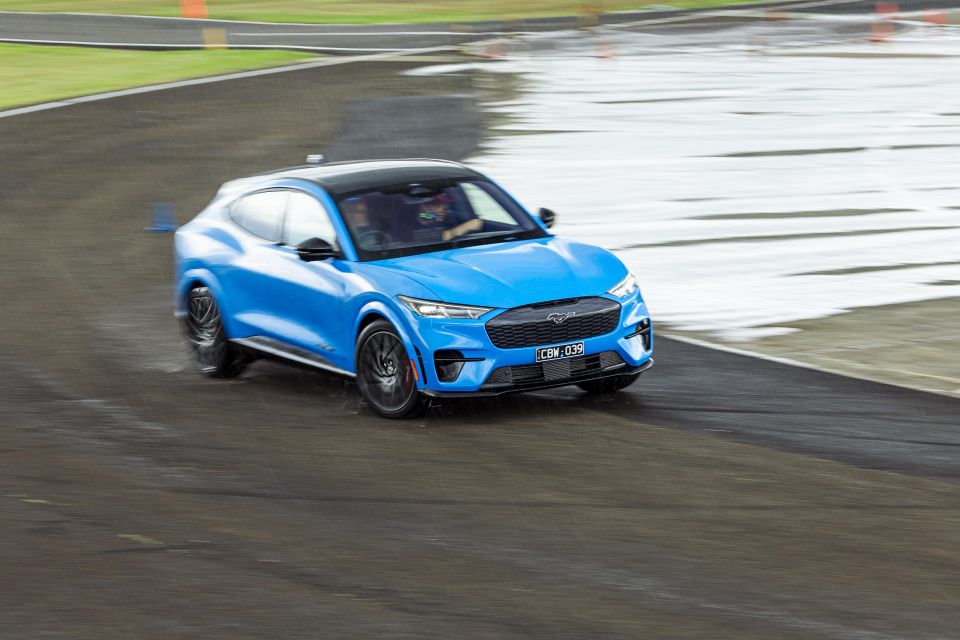
Ford didn’t try to make the Mach-E sound like a spaceship, nor did it program in some faux V8 soundtrack.
My time with the Select was more limited than with the Premium, but it did leave an impression. It felt fractionally lighter, even though it’s actually a few kilograms heavier, and it didn’t feel noticeably less powerful than the Premium.
The GT we drove didn’t leave the track, but we got the opportunity to do a handful of loops at the Norwell Motorplex, run it through a small slalom, and tackle the skid pan.
The sudden storm, however, left the track mighty wet so I didn’t push the GT quite as much as I would have liked – or as much as it could probably have handled.
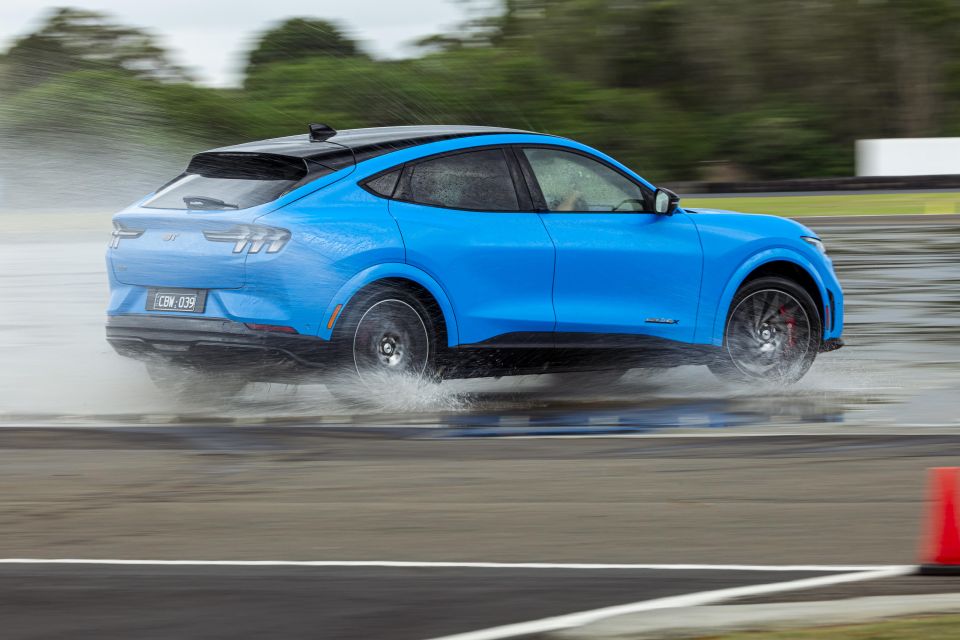
The inclusion of all-wheel drive naturally improves grip but it doesn’t spoil the rear-drive thrills, and we were able to get the rear wheels out once or twice – though again, the track was very wet.
We also got to try 0-100km/h runs in each of the drive modes, bar the GT’s exclusive Untame Plus track mode. There’s a noticeable difference in traction, with more tyre scrabbling as you step up through the modes.
The Mustang Mach-E has the hardware for BlueCruise, Ford’s driver assist system that allows for hands-free driving on over 200,000km of roads in North America.
You can even see the eye reader on the steering column, but the system isn’t enabled in our market with Ford blaming regulations.
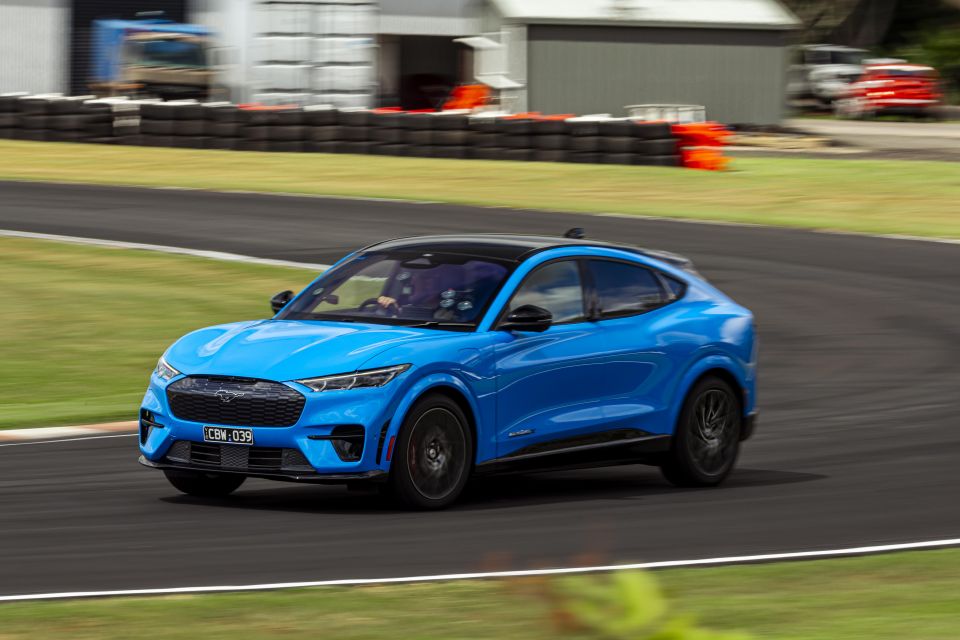
All models have lane-keep assist, as well as a lane-centring function.
With the lane-keep assist, you can select between just an aid or an aid with an alert, and you can adjust the alert intensity between high, medium and low. To turn the system off entirely, you press the lane button on the steering wheel twice.
The lane centring works in conjunction with adaptive cruise. It works quite well, though it did briefly cancel a couple of times despite no apparent break in lane markings.
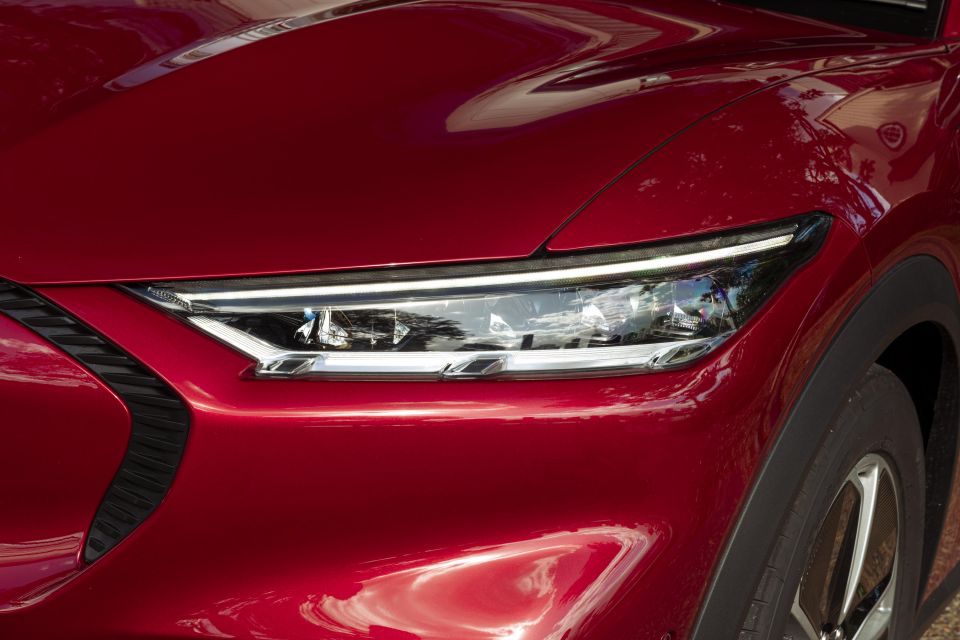
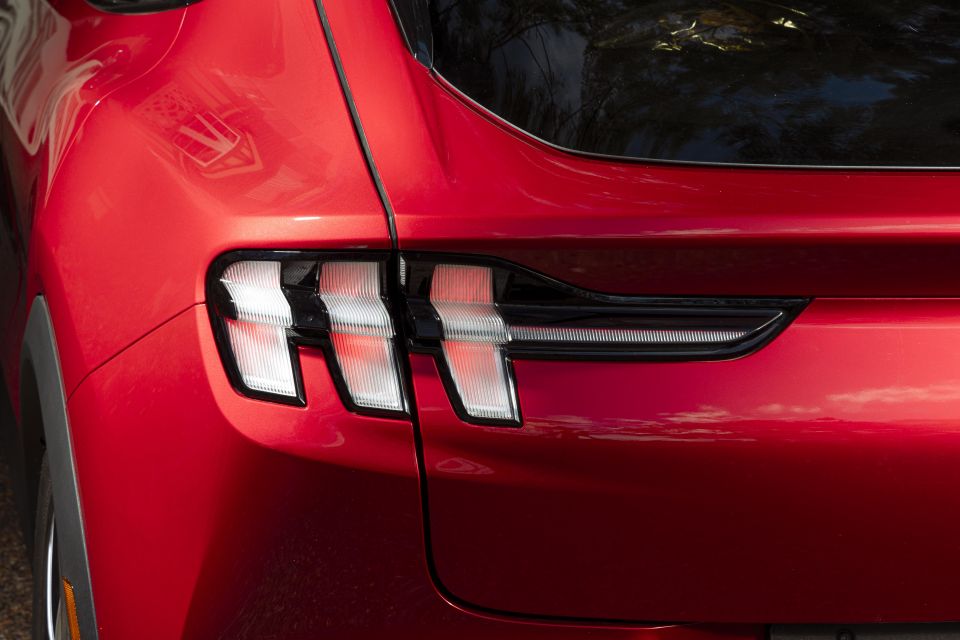
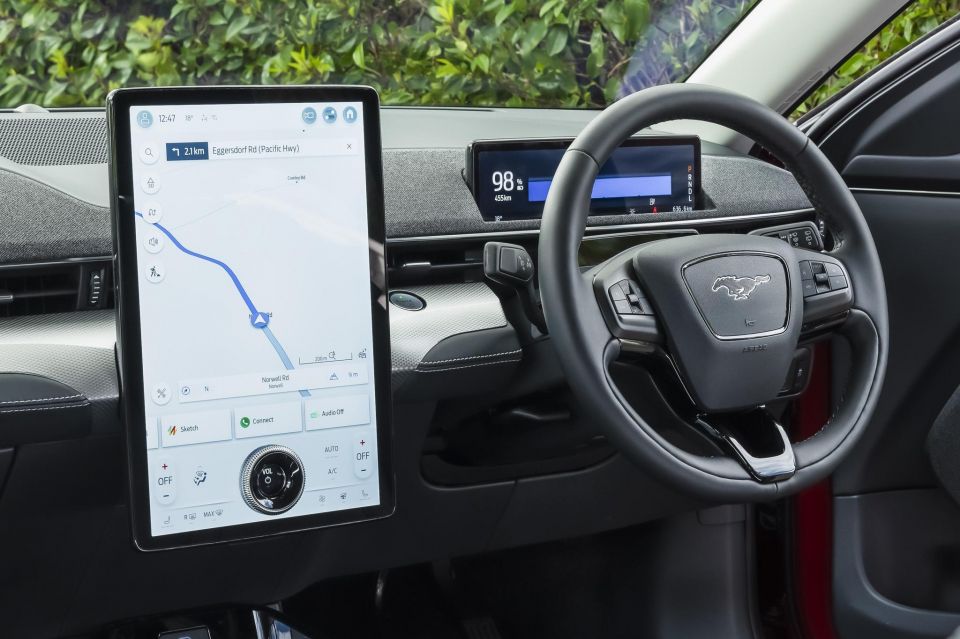
Mustang Mach-E Select highlights:
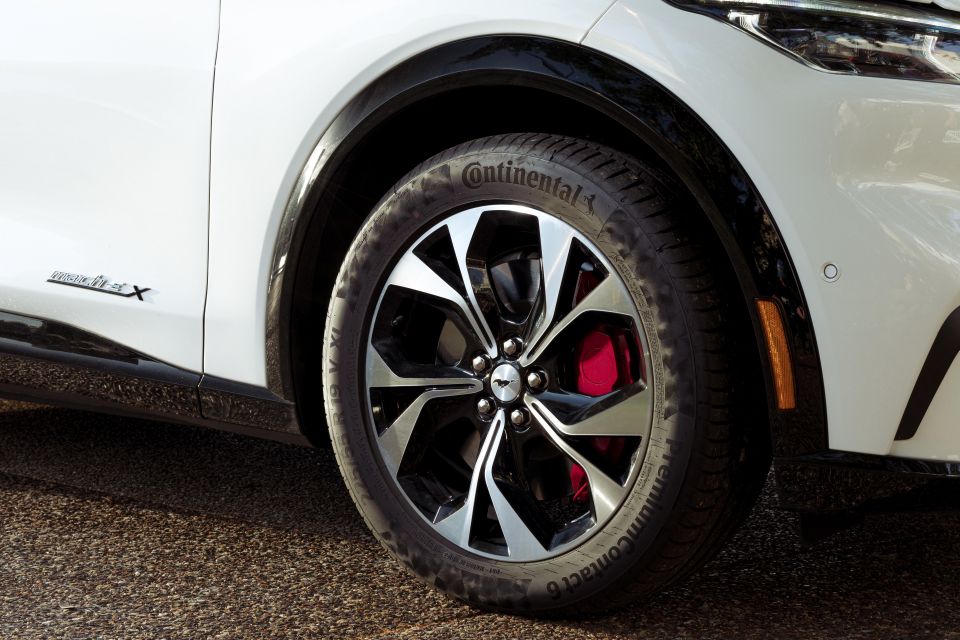
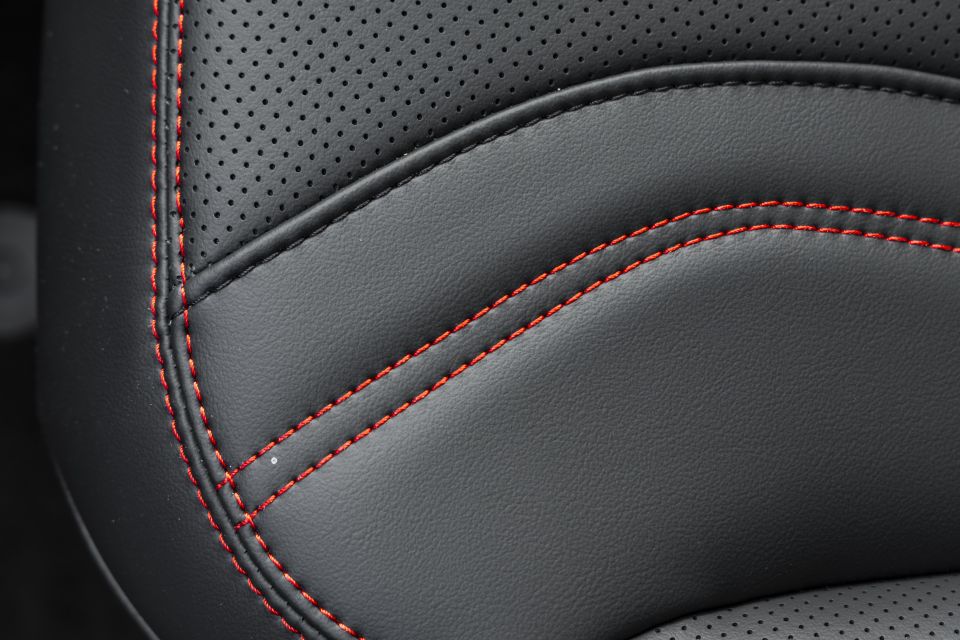
Mustang Mach-E Premium adds:
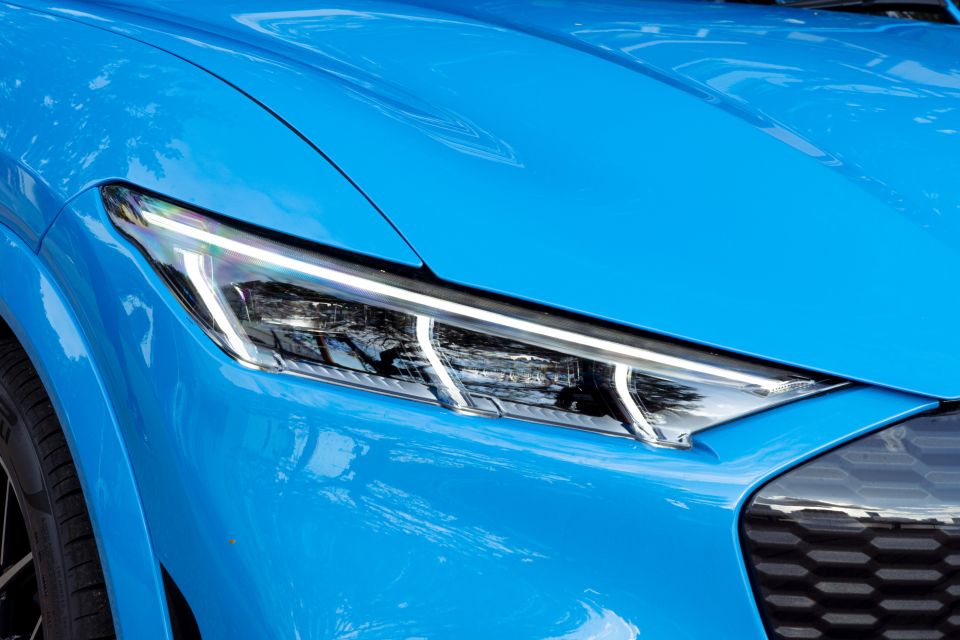
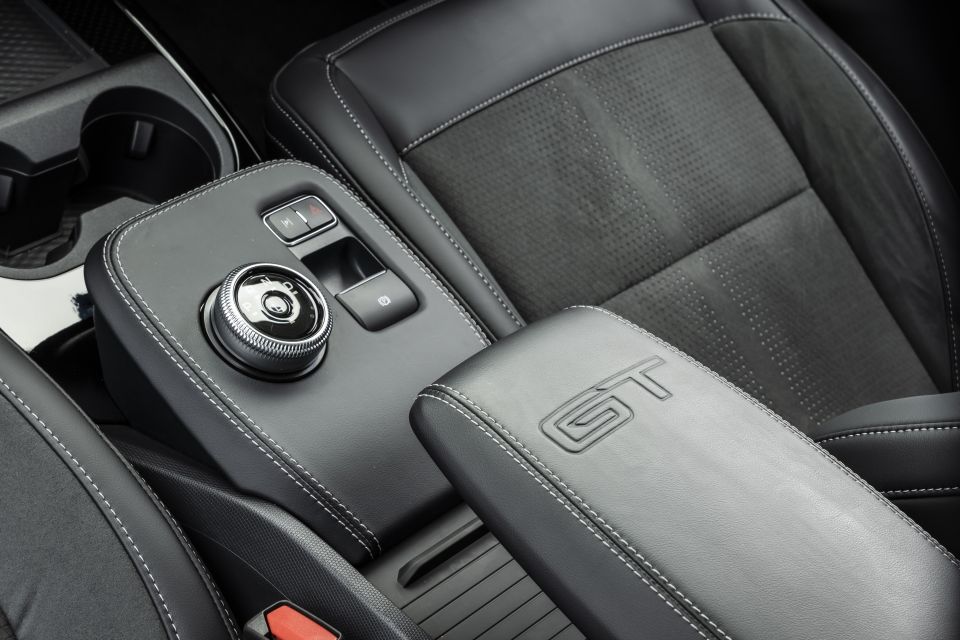
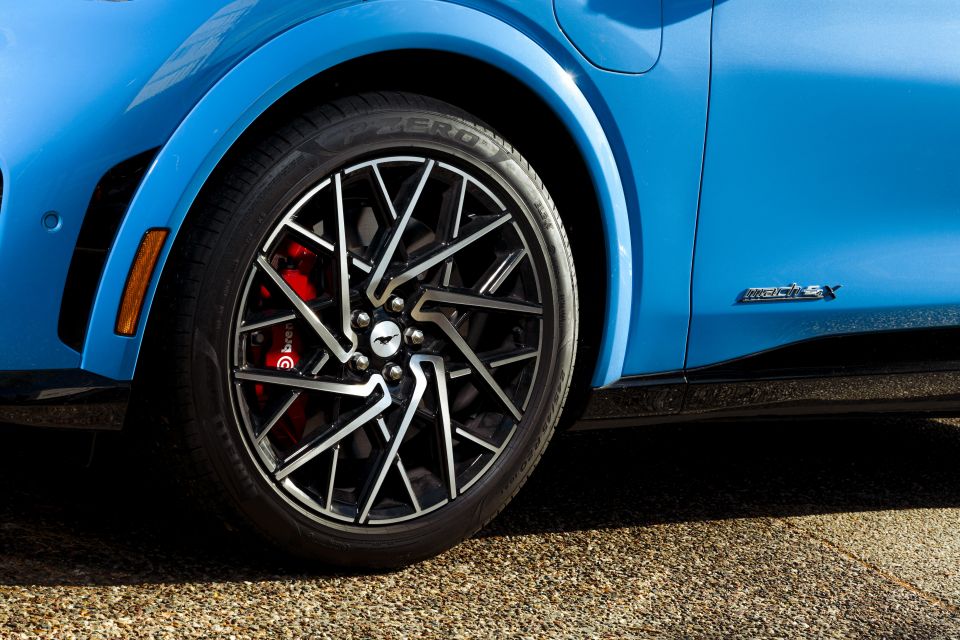

Mustang Mach-E GT adds:
The Mustang Mach-E has FordPass connectivity as well as FordPass Power My Trip, which will find charging stations along a route that is entered into the satellite navigation.
There are no options on any variant apart from paint, with all finishes bar Shadow Black costing an extra $700.
The Mustang Mach-E has a five-star ANCAP safety rating, though the GT misses out and is unrated. Notably, the GT misses out on a front-centre airbag.
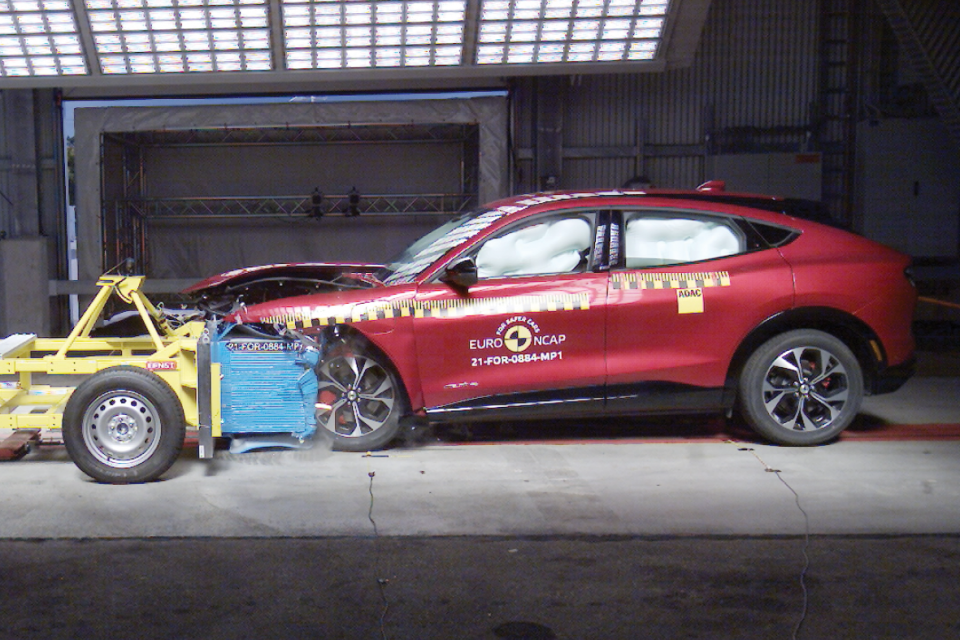
It received an adult occupant protection rating of 92 per cent, a child occupant protection rating of 86 per cent, a vulnerable road user protection of 69 per cent, and a safety assist rating of 86 per cent.
The Mustang Mach-E comes standard with:
The Mustang Mach-E is covered by a five-year, unlimited-kilometre vehicle warranty and an eight-year, 160,000km battery warranty.
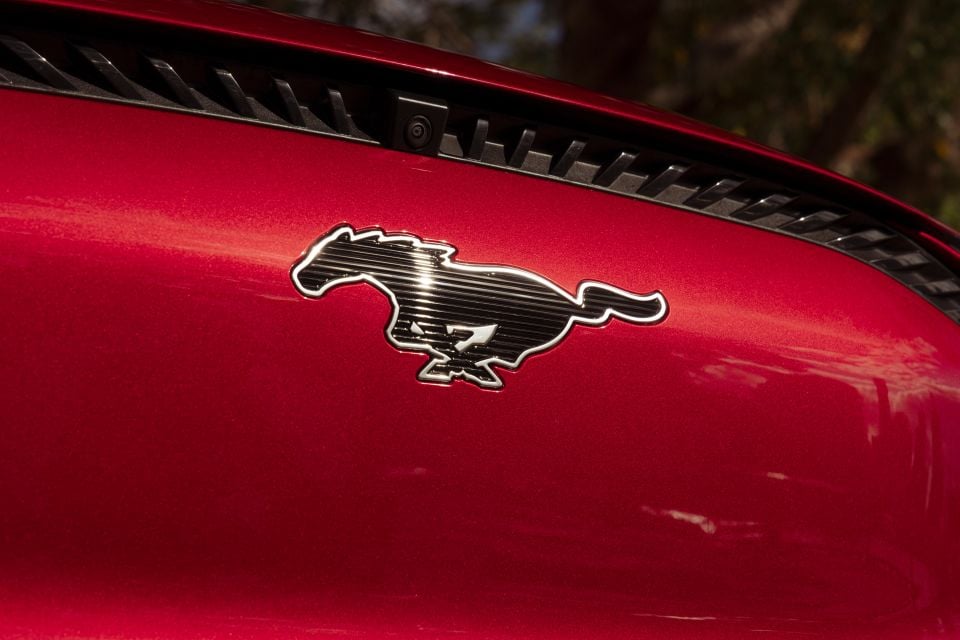
Servicing is required every 12 months or 15,000km. Ford provides service pricing for the first 10 years or 150,000km of ownership, with every second service priced at $180 and all other services priced at $135.
Buy your new car without the stress. It's fast, simple and completely free.

Great service from Travis and team, second time I have used this business would not hesitate to recommend them to anyone
Craig C.
Purchased a Ford Ranger in Sunshine Coast, QLD
CarExpert helped Craig save $7,224 on his Ford Ranger, now let us save you on your next new car.
Get your BEST priceThe Ford Mustang Mach-E is stylish, practical and fun-to-drive, but does it have the X-factor to stand out?
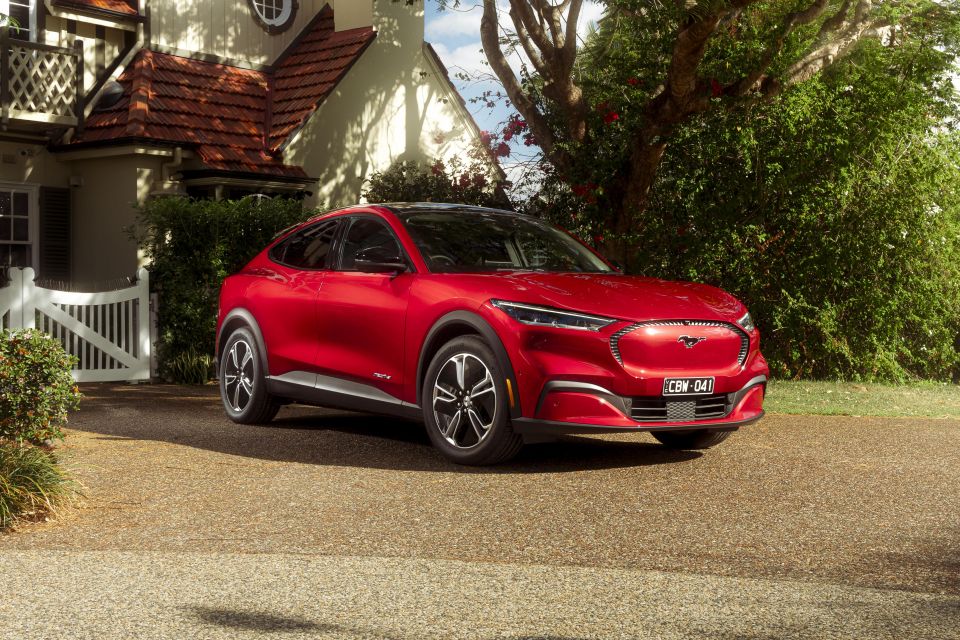
It could face the same problem likely to befall the upcoming Nissan Ariya and Volkswagen ID.4: it’s arriving in Australia much later than it did in other markets, and therefore faces so much more competition than had it not been so tardy.
The Model Y has already sewn up this segment, and is currently outselling all of its rivals combined.
To make matters worse, Ford’s pricing – particularly for the base grade – is quite steep. Certainly a Mach-E Select has some features a base Model Y doesn’t, and arguably much more style, but is it worth $14,000 more?
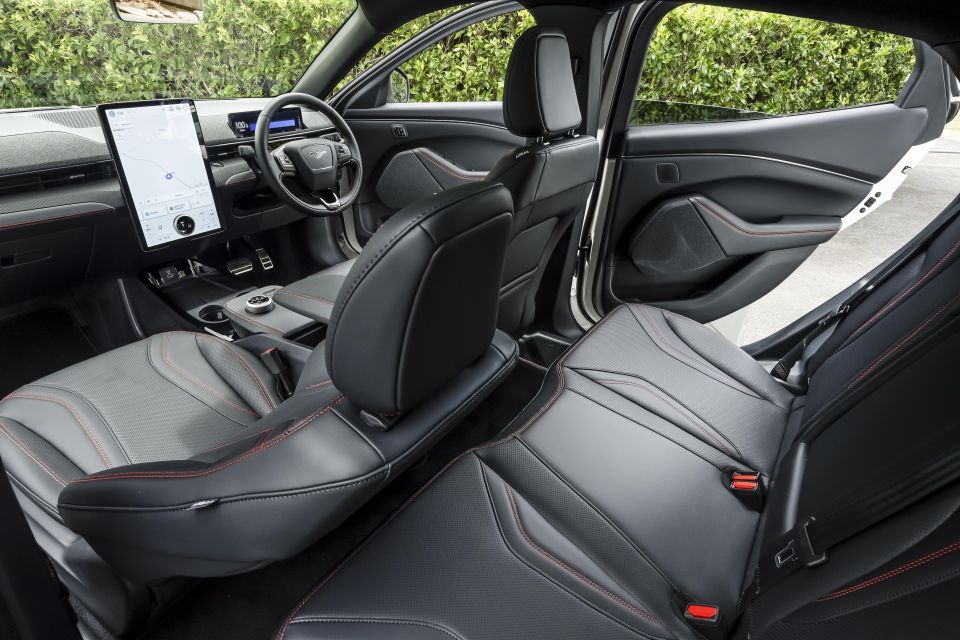
Ford says upwards of 65 per cent of Mach-E buyers globally have been new to the brand. Let’s see if that applies here.
While many new EVs show obvious appeal to owners of their brands’ combustion-powered vehicles looking to go electric, the Blue Oval’s presence in the medium-to-large crossover market has been weak for several years now (see: the dying Escape, the dead Endura) so it’s unclear what owners are going to be trading in for this new EV.
Premium pricing aside, the Mustang Mach-E is spacious and refined, and is a compelling alternative to the likes of the Model Y, EV6 and Ioniq 5.
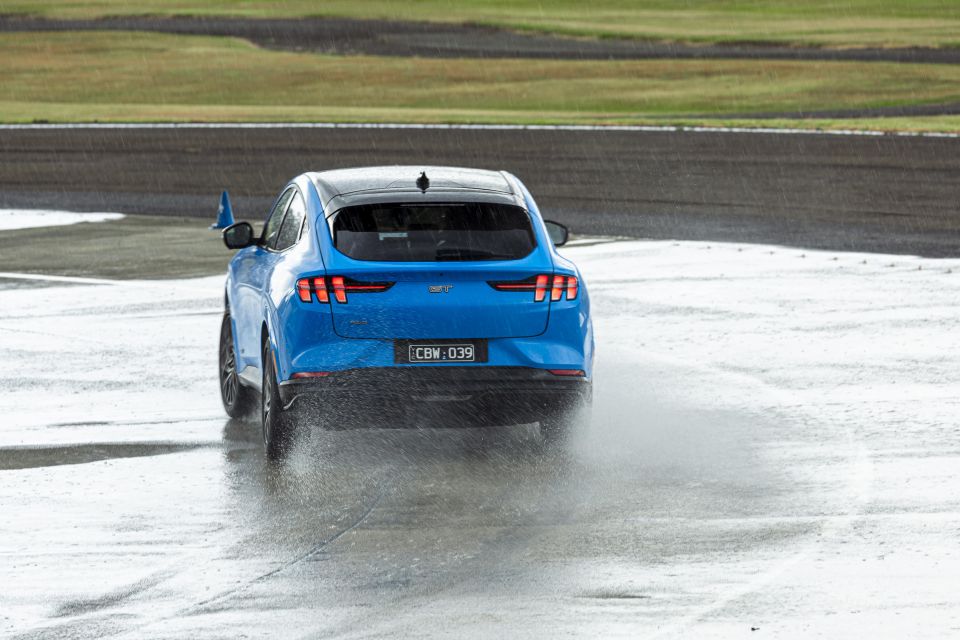
Click the images for the full gallery
Where expert car reviews meet expert car buying – CarExpert gives you trusted advice, personalised service and real savings on your next new car.
William Stopford is an automotive journalist based in Brisbane, Australia. William is a Business/Journalism graduate from the Queensland University of Technology who loves to travel, briefly lived in the US, and has a particular interest in the American car industry.


Max Davies
6 Days Ago
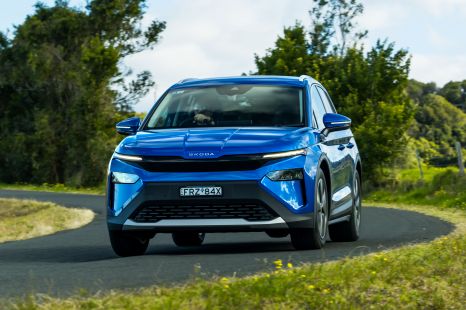

Josh Nevett
4 Days Ago
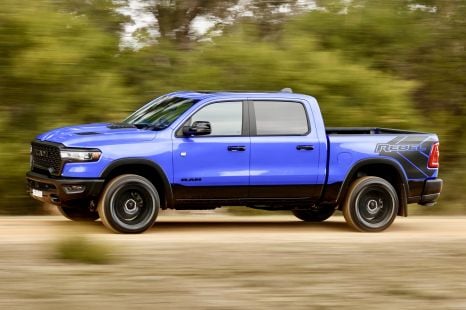

Max Davies
4 Days Ago


Max Davies
3 Days Ago
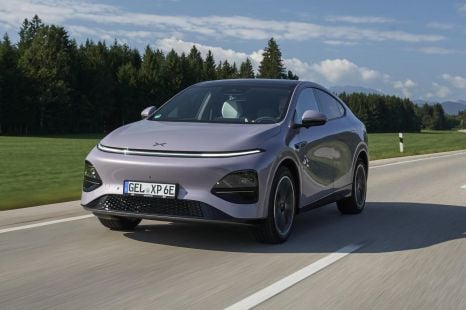

Neil Briscoe
2 Days Ago
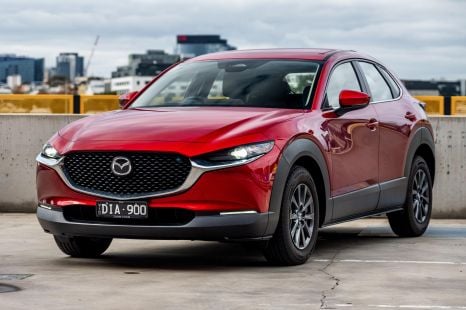

Max Davies
20 Hours Ago